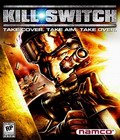Genre : Action
Publisher: Namco
Developer: Namco
Release Date: October 29, 2003
Buy 'KILL.SWITCH': Xbox | PlayStation 2
 War is started by poor relations, misconceptions, and power hungry organizations. While we cannot stop war, we can try our best to delay the inevitable by using special agents or special units. We may not know it, but spy factions are extremely vital to a mission's success, without which we can never truly succeed in war. They give necessary tactical information and even pull a hit when ordered to. So how would an army equipped with an incredibly strong computer system fare? You'll find out in Kill.Switch.
War is started by poor relations, misconceptions, and power hungry organizations. While we cannot stop war, we can try our best to delay the inevitable by using special agents or special units. We may not know it, but spy factions are extremely vital to a mission's success, without which we can never truly succeed in war. They give necessary tactical information and even pull a hit when ordered to. So how would an army equipped with an incredibly strong computer system fare? You'll find out in Kill.Switch.
The game is a third-person shooter, and you take control of an individual operative named Bishop, whose goal is to take out the opposing army. Sam Fisher from "Splinter Cell" tried this task and succeeded, but he was also equipped with state-of-the-art technology. So what does Bishop have to aid him in this massive undertaking? Rather than having technologically-advanced weaponry, Bishop is equipped with a state-of-the-art fighting system. In a sense, you can even consider Bishop to be a human cyborg, a walking human computer trapped inside of a real-life war game.
The controls in the game are very user-friendly, which is especially important for the PS2. Third-person or first-person shooters are always harder to play on console than the PC, which is why most gamers prefer to stay away from console shooters. The mouse is just such a powerful aiming device that no controller can ever match, but for some gamers, you may get used to the controls. Since I have already played "SOCOM," I have a firm grasp of the controls: R1 is the industry standard for firing, R2 is to reload, L1 to take cover or duck, triangle to interact with the objective points, circle to weapon bash, X to dive, and square to throw grenades. Left and right on the directional pad are used to cycle through weapons, while down and up to choose different types of grenades. Last, but certainly not least, R3 goes into sniper mode if the gun has the ability. You will get to try out these button configurations on the first level tutorial. With these controls down, it's time to take Bishop out for a ride of his life.
The game starts out immediately in a mission, and objectives for each mission are never the same, ranging from assassinations all the way to destroying specified targets with explosives. If you think these missions are going to be a cinch, you can stop kidding yourself. Unlike "Splinter Cell," where you can stealth kill all of your enemies, this game requires you to Rambo yourself to your objectives. Since you are the one infiltrating, this gives the enemy the upper hand in two ways: they are more familiar with the surroundings, and they are already setup to annihilate you. At any given time, you will almost always be outnumbered 5 to 1, not exactly the best odds but this is your mission, and failure is not an option. Unlike other games, this game requires you to pick up enemy weaponry, something that I have always wanted to see in this type of game. It is extremely crucial that you do so because unless you have the skill of a sniper, ammo runs out extremely quickly. So what guns are available for us to use?
The guns available would be M4, M203, AK47, AKU, AKUG, HK5a3, HK5SD5, M1, MCRT 300, M249, grenade, mini grenade, sticky grenade, and flash grenade. These weapons vary in power and amount of ammo per clip as well as maximum ammo available, although most have 150 rounds, with exceptions like the MCRT, which has a maximum of 25. In the game, you will never really know which gun you are using unless you memorize the pictures corresponding to the gun or the sound. Each gun has a different sound so if you can recognize it, you can tell which weapon you or the enemy is firing. Knowing the type of weaponry the enemy has gives you the upper hand in choosing whether you face them head-on or take cover and fight cautiously. As I mentioned, guns have different strengths so if you fought an M1 user (shotgun) straight on, two hits and you are dead. Since you know the sound of the gun, you also know that rushing up and trying to outgun him wouldn't be the smartest move. The rocket launcher is the only weapon that can kill you in one hit, and trust me, Rocket Soup a la Hank is not very tasty. I've already had my fill. Luckily, the only time you will see the rocket launcher would be the final stages, and you will truly appreciate that. It is also a special weapon that you cannot pick up, which I wish Namco had changed. However, guns aren't your only methods of defeating the enemy, and grenades are man's best friend. If you actually time the throw correctly, you will get to enjoy watching the enemy be blown into the sky. Unfortunately, there are no chunks and pieces, but I guess you can't have that in a T-rated game. There is one grenade which doesn't blow the enemies away and this would be the flash grenade, better known as the flash bang. The grenade blinds the opponents and possibly yourself, if you are too close. Once they are hit, their guns will be pointed towards the ceiling, rendering them unable to hit you and giving you a perfect chance to take them out. Each level requires you to use a good amount of weaponry and grenades listed above.
Levels are unique and never have the same structure as another, requiring the player to use different tactics for different missions. These missions are fought in an open field or close quarters. Since there is such a difference in level structure, it isn't the wisest idea to always go in with guns blazing, especially in an open field, where you can get mowed down quite easily. I swear the AI are all snipers, especially when they are equipped with the stationary turrets. Never face these head on because they are protected by the turret shields and can only be killed if you hit them in the head. It isn't the easiest task, but after a few rounds of fire, you may get lucky and hit him, hopefully without sustaining too much damage. In addition, some levels even have a helicopter that comes in as enemy support; try to avoid this occurrence at all costs because there is no way to destroy the chopper. Most battles take place indoors so this will rarely occur. Levels do alternate between indoor and outdoor venues, but the indoor battles are far more memorable, but that might just be personal preference. With only one exception, I truly hate the last indoor battle in "What She Says." The scene is incredible similar to the one in "The Rock" where the enemy has higher ground, which, in war tactics, can only lead to one of two possible conclusion: death or capture. Boy, did that prove true in my case. If I didn't die by a rocket launcher, I died in this room, and I think I replayed this mission a good 50 times or more to beat it by finally using the level to my advantage.
Levels are always stacked with covered areas and boy, are they helpful. Make sure you follow this whenever possible going in Rambo style is fun but if you cannot complete mission this way hold back take cover and let your life recover. During this time, use the blind fire or peek option to observe the terrain and fire at opposing enemies. It may not be the most glorious way to complete a mission, but war was never meant to be glorious. A victory is a win so use whatever means necessary to change the momentum in your favor.
There are a total of six missions: Training Simulator, Middle East, Caspian Sea, North Korea, Temple Ruins, and Archer Base. Within each mission are several levels so the game is quite extensive. If you play long enough, you would start to know when you have reached the final room, and since I died so much, it almost became a skill. Since you cannot save the game until you have completed the stage, the game allows the player to have an infinite amount of continues. Even if you die, you will eventually understand the stage and figure out the necessary tactics to defeat the enemy. As mentioned before, there are objectives that you must complete, but there are two stages that also have timers so make sure you keep an eye out for those, or else it'll be game over.
I've covered several aspects of the game, but probably the best aspect is the life. Unlike SOCOM, you do not die in one hit by standard weapons. You actually have a life bar that shows how much health you still have, and if you wait long enough, your life bar actually replenishes a bit, depending on how much damage you incurred. While playing, you should always look for the med kits, which are placed in the most obvious but oblivious places. These kits revive the entire life bar so pick them up when you need them or when you have completed a tough battle. Make sure you look around your environment for these med kits, for they can lead to your success or failure.
The environment in the game is spectacular. The graphics detail is very well done and quite noticeable. You can clearly distinguish which object is what, and some objects even have the ability to be destroyed, such as glass windows. Levels are never the same so you can see that Namco implemented different styles of background to give each level a unique feel. The character models are also excellent, with plenty of detail, especially the in-game characters, and for some reason, Bishop's character model reminds me of SC's Sam Fisher. In "Splinter Cell," the facial features were excellent, and you could truly see the facial expression in Kill.Switch. You never really require facial features so the only time you will see them would be in the CG scenes, and these were so amazing that I still have one CG scene constantly running through my head. I don't want to spoil it for you, but it's very Matrix-like, and you absolutely must play the game, if only to watch this cut scene. Even with the awesome CG and background, there are two things that I disliked about the graphics: the character model of the girl is extremely scary, and when the gun is dropped by the enemy, it is slightly difficult to tell what type of weapon it is other than when you run over it or pay attention to the sound of the gun when the enemy was firing it.
One thing that really boosts Kill.Switch is the talent of the voice actors, who do a superb job of bringing the characters to life. Other aspects of the game's sound are equally impressive. Unlike other games of this genre where the gun and fighting sounds are the primary focus, this game's focus is actually on the background music, which is definitely an important factor. Each level has its own unique music, and although the song repeats throughout the level, you never get sick of it, which shows how well the song fits with the game. You will also hear voices from your operator, enemy war cries, and explosions.
 Overall, this game is very solid and definitely a new arena for Namco. The game runs flawlessly and is extremely fast-paced. It may not be Quake, but for PS2 to be able to handle speeds of this caliber is just amazing. The game is very well thought-out and actually fairly fun to play. The level of difficulty is pretty high, but if you are a really good player, you can breeze through with ease. One thing this game lacks is replay value. There are only two difficultly levels to play, normal or hard, which would be more adequately described as hard and brutal. This game also lacks a multiplayer component, which would have made the game a strong contender against "SOCOM." These days, you simply can't have a shooter without multiplayer capability. Maybe they will develop this feature for the next installment, in which case this game is a must-have.
Overall, this game is very solid and definitely a new arena for Namco. The game runs flawlessly and is extremely fast-paced. It may not be Quake, but for PS2 to be able to handle speeds of this caliber is just amazing. The game is very well thought-out and actually fairly fun to play. The level of difficulty is pretty high, but if you are a really good player, you can breeze through with ease. One thing this game lacks is replay value. There are only two difficultly levels to play, normal or hard, which would be more adequately described as hard and brutal. This game also lacks a multiplayer component, which would have made the game a strong contender against "SOCOM." These days, you simply can't have a shooter without multiplayer capability. Maybe they will develop this feature for the next installment, in which case this game is a must-have.
Score: 9.0/10
More articles about Kill.Switch


















































